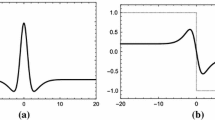Abstract
The spatial information capacity of the human eye for photopic vision has been determined taking into account the intensity response function of the photoreceptor. It has been found that spatial information capacity increases with the mean luminance upto a certain value of mean luminance and after that it starts decreasing. The decrement occurs below the damage threshold. These results are in agreement with the reported experimental observations. It has been concluded that the limited number of Na+ channels in the photoreceptor outer segment and the photon noise are responsible for the fall in the information capacity below the damage threshold.
Similar content being viewed by others
References
Ditchburn, R.W., Drysdale, A.E.: Visual information obtained from flashes and from afterimages. Vision Res. 13, 2435–2447 (1973)
Goldman, S.: Information theory. Englewood Cliffs: Prentice-Hall 1953
Gupta, B.D., Sharma, A.: Spatial information capacity of human eyes. Optik 60, 259–270 (1982)
Hagins, W.A.: The visual process: excitatory mechanisms in the primary receptor cells. Annu. Rev. Biophys. Bioeng. 1, 131–158 (1972)
Hagins, W.A., Penn, R.D., Yoshikami, S.: Dark current and photocurrent in retinal rods. Biophys. J. 10, 380–412 (1970)
Hopkins, H.H.: The frequency response of a deforcused optical system. Proc. Roy. Soc. (London) 231A, 91 (1955)
Korenbrot, J.I., Cone, R.A.: Dark ionic flux and the effects of light in isolated rod outer segments. J. Gen. Physiol. 60, 20–45 (1972)
Osterberg, G.: Topography of the layer of rods and cones in the human retina. Acta Ophthal. 13, Suppl. 6 (1935)
Penn, R.D., Hagins, W.A.: Signal transmission along retinal rods and the origin of the electro-retinographic a-wave. Nature 223, 201–205 (1969)
Penn, R.D., Hagins, W.A.: Kinetics of the photocurrent of retinal rods. Biophys. J. 12, 1073–1094 (1972)
Sillman, A.J., Ito, H., Tomita, T.: Studies on the mass receptor potential of isolated frog retina. II. On the basis of the ionic mechanism. Vision Res. 9, 1443–1451 (1969)
Snyder, A.W., Miller, W.H.: Photoreceptor diameter and spacing for highest resolving power. J. Opt. Soc. Am. 67, 696–698 (1977)
Snyder, A.W., Laughlin, S.B., Stavenga, D.G.: Information capacity of eyes. Vision Res. 17, 1163–1175 (1977a)
Snyder, A.W., Stavenga, D.G., Laughlin, S.B.: Information capacity of compound eyes. J. Comp. Physiol. 116, 183–207 (1977b)
Werblin, F.S.: Regenerative hyperpolarization in rods. J. Physiol. 244, 53–81 (1975)
Yoshikami, S., Hagins, W.A.: Ionic basis of dark current and photocurrent of retinal rods. Biophys. J. 10, 60a (1970)
Zuckerman, R.: Mechanisms of photoreceptor current generation in light and darkness. Nature New Biol. 234, 29–31 (1971)
Zuckerman, R.: Ionic analysis of photoreceptor membrane current. J. Physiol. 235, 333–354 (1973)
Author information
Authors and Affiliations
Additional information
Associated with the Biochemistry Cell
Rights and permissions
About this article
Cite this article
Gupta, B.D. Spatial information capacity of eyes: Roles of Na+ channels and photon noise in photoreceptor. Biol. Cybern. 50, 395–400 (1984). https://doi.org/10.1007/BF00335196
Received:
Issue Date:
DOI: https://doi.org/10.1007/BF00335196




